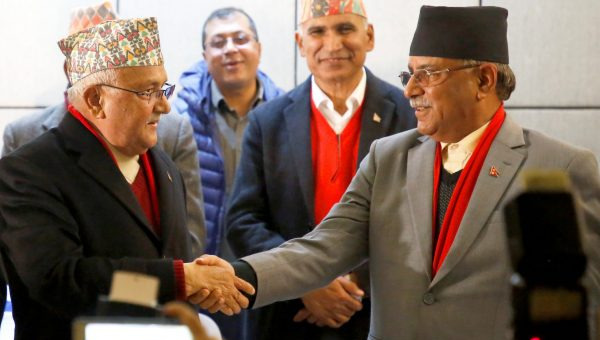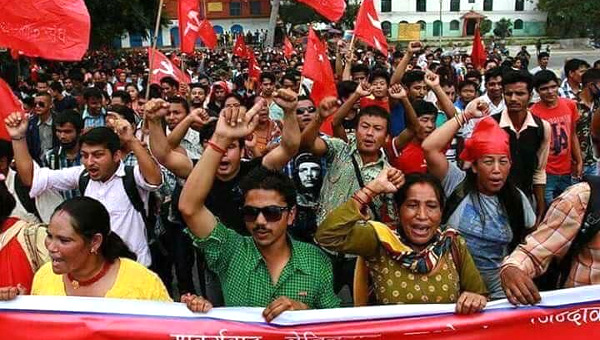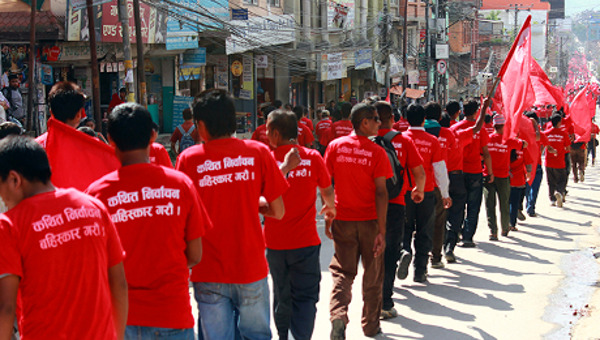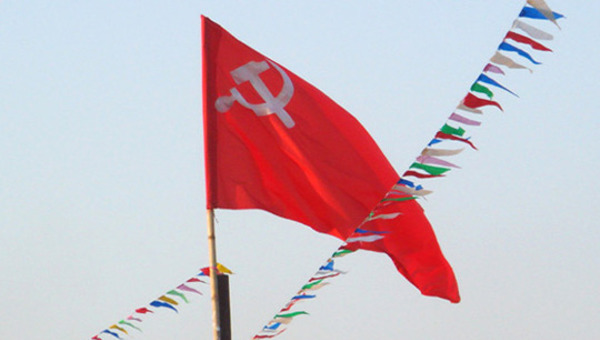After ten years of Maoist insurgency and a coup d’état by the king in 2005, the Nepali people took to the streets in April 2006, forcing the king to hand power back to the parliament. It was the end of the only Hindu kingdom in the world but only a new step in the country’s continuing political crisis. The Maoist party, the UCPN(M) has entered into a crisis itself and a split has become inevitable.
For six years since 2006, the Nepali government has been unable to draft the Constitution that should have been the foundation of a new, democratic Nepal. The Constitutional Assembly (CA), elected in 2008, originally had a two year mandate but even after this had been extended several times, it remained in a deadlock, unable to reach any agreement. Ignoring a Supreme Court verdict that the CA could not be extended, Prime Minister and Maoist vice-chairman Baburam Bhattarai tabled a bill proposing just that. The Supreme Court ruled against him on contempt charges and at midnight May 28th Bhattarai dissolved the CA and called for new elections.
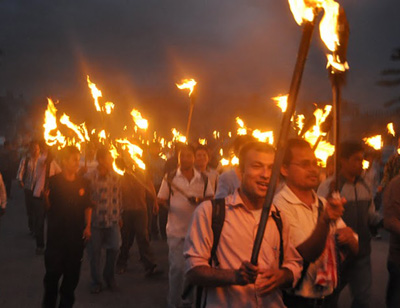
The final stumbling block was the refusal of the anti-Maoist coalition in the CA to allow changes in the structure of the state that would give greater autonomy to a number of the country’s minorities.[1] It was the end of the second Maoist-led Nepali government. The Right hopes that the elections will give them the chance to grow big enough to not only block any progress in the CA, like they have done for the last four years, but also influence its course.
The Maoists hope that the elections will be a chance to break the deadlock but with increasing division in their own ranks it is uncertain they can repeat their surprise electoral victory of 2008. Inside Bhattarai’s party, the United Communist Party of Nepal (Maoist) (UCPNM), that led a decade of armed struggle and controlled most of the country before agreeing on a cease-fire with the government, criticism of the leadership has been growing. Bhattarai and other leaders have been accused of betraying the revolution and preparations for a split have been going under way for months. To understand the crisis of the UCPN(M) and the end of the second coalition government led by it, it is necessary to look at the evolution of its leaders’ strategy.
A New Step in the Crisis
Negotiations between the establishment parties and the Maoists, building on a framework from 2005, led in May 2006 to a ceasefire and the signing of the Comprehensive Peace Agreement (CPA) in December 2006. After long delays, elections for an Assembly that would draw up a new Constitution and function as an interim parliament took place in April 2008. Surprising most observers, the Maoists won a huge electoral victory, winning one third of all seats and becoming the largest party in parliament. Their chairperson, Pushpa Kamal Dahal, better known under his nom de guerre Prachanda (‘the fierce one’), became Prime Minister.[2]
But the crisis of Nepali politics has continued. For a long time, the main contradiction was between the old parliamentary parties on one hand and the Maoists on the other. The most important of these old parties are the conservative Nepali Congress (NC) and the Communist Party United Marxist-Leninist (UML, a party that is neither Marxist nor Leninist and supported the king for most of the insurgency).[3] Together with other establishment forces these parties have been resisting radical change and the drawing up of a new constitution that would alter the existing power relationships to their disadvantage. On the other side were the Maoists who commanded an apparatus and electoral support that overshadowed that of any other single party but who were relatively unfamiliar with the game of parliamentary politics and had influence in the patronage based political machines.
The Maoists emphasized that they had not given up their goal of social revolution and that their participation in parliament was only a step toward this. In the Maoism of the UCPN(M), the revolution would need to go through two stages. First is the ‘New Democratic Revolution,’ as a step toward the establishment of socialism.[4] This first stage is meant to finish ‘bourgeois democratic’ tasks like land-reform, equal rights for all citizens and abolishing the monarchy and protecting national sovereignty, especially against traditional rival India. Although the Nepali Maoists had come out in favor of a multiparty system, including under socialism, they insisted that this first phase would be under leadership of the revolutionary forces and would immediately begin laying the groundwork for the second phase, that of socialist revolution.[5]
Since 2006, the establishment parties and the ruling classes of Nepal, with help of the United States and especially India, have been trying to channel the Maoists into parliamentary, institutionalized politics and convince them to postpone the New Democratic Revolution to some far undefined future. Nepal’s fractured political landscape is dominated by patronage networks and the establishment parties have been trying to integrate the Maoists into these networks and its political institutions and neutralize them, just like the parties that now form the UML have been neutralized years ago.[6] After a failed attempt at insurrection in 2010 and especially the disarmament and dissolving of the Maoist armed wing, the People’s Liberation Army (PLA), and numerous other concessions by the UCPN(M), worries in the dissident camp that establishment forces succeeded in this have been growing. This has led to a new contradiction, this time inside the UCPN(M), between it’s right and left-wings.
Divisions
The last few years the UCPN(M) was actually divided in three power-centers. The right-wing was mostly closed identified with Baburam Bhattarai. Eloquent and highly educated, Bhattarai has been the chief diplomat of the UCPN(M), responsible for reaching out to other political forces and leading an important united front like that of the various national liberation organizations of Nepali minorities. He is the party’s number two after Prachanda and is also considered to be their most important theorist. Bhattarai has long argued that under the current geopolitical circumstances a revolution with a socialist orientation is impossible in Nepal. He cites Nepal’s position between capitalist China and pro-U.S. India, its small population and the lack of natural resources or economic means and the low level of development as arguments for this. Nepal has a population of less than 30 million. In 1998, two years after the Maoists launched their ‘people’s war,’ approximately 82 per cent of Nepal’s work force was employed in the agricultural sector, with a large majority being smallholders, tenants who have to provide their landlords with at least half of their harvest and free services in return for the use of a plot of land and subsistence security, or landless peasants. Nepali agriculture remains underdeveloped and ranks among the very lowest of South Asia in terms of crop yield and value added per worker.[7] In 2000, adult literacy nationwide was a little over 50 per cent and life expectancy was under 60 years.[8] Indentured labour was only legally abolished a few years ago and still exists. The Human Development Index of the United Nations ranks Nepal 137th out of 177 countries.
Another cause of instability in Nepal is the oppression of a large number of minorities. Already before the people’s war, Nepal was officially recognized as ‘multi-ethnic’ and ‘multilingual,’ with various ‘national languages.’ But the demand of the pro-democracy movement that Nepal should become a secular state and the privileged status of Hinduism ended, was rejected. Nepal remained a Hindu monarchy and the king was celebrated as a living god. The state policy favored Hindus and the caste system remained intact. This policy marginalized a large and diverse part of the Nepali population. Officially, there are 44 minority ethnic groups in Nepal, making up over one third of the total population. The Hindu caste-system is also applied to the minority groups, delegating them to the lower castes. These groups are underrepresented in the state apparatus, in elected positions and are disadvantaged by the concentration of power in the Kathmandu valley.[9] Laws on marriage, divorce and inheritance were based on Hindu norms and extremely disadvantageous for women.
In the face of this lack of democratic and economic development, Bhattarai has been arguing that Nepal needs to pass through a pre-New Democratic ‘substage’ in which the progressive movement would not just limit itself to democratic tasks, not touching private property, but also accept the political hegemony of pro-capitalist forces.[10] Since the signing of the CPA, Bhattarai has been reaching to out India and the UCPN(M) has established contact with the Indian Communist Party (Marxist), long one of the ruling parties in large parts of India, and taking over their investment based, developmentalist approach.

Red Faction
Already before the signing of the CPA, the approach of Bhattarai was criticized by other forces in the Maoist party. A left-wing current crystallized among the Maoists, already in 2009 leading to a small split under the leadership of Matrika Yadav, a former parliament- and politburo-member, who said the UCPN(M) was no longer sincerely striving for revolution. A more significant left-wing current remained in the party but is now leaving as well. Among its leaders are Netra Bikram Chand (party name: Biplab), Chandra Prakash Gajurel (aka Gaurav) and Mohan Vaidya (aka Kiran), all prominent UCPN(M)-cadres who have been pressing for a more radical course and the preparation for an insurrection to seize power for years. The recent disarmament of the PLA seems to have been the last straw for them. Since then this faction has formed a united front with forces to the left of the party in March 2012 to campaign against the policies of the UCPN(M)-led coalition government and grown more and more vehement in its denouncements of the UCPN(M) leadership.[11] The left-wing faction’s orientation is much more classically Maoist, insisting on the (long term) possibility of armed revolution. The left-wing has also urged more cooperation with the Indian Maoists, the Communist Party of India (Maoist), also known as Naxalites, a party that sticks more closely to Maoist orthodoxy than the UCPN(M).[12]
Balancing between the right-and left-wings was Prachanda, allying with one, then the other wing in the intense faction fights, forging compromises on policy papers, reaching out to establishment forces one month, alluding to an insurrection the next, but always making sure he stayed in power.[13] But now it seems the party’s right-wing has won the power struggle and the left-wing no longer distinguishes between Bhattarai and Prachanda. The end of the PLA was also a blow to the support base of many of the left-wing leaders. In the highest party organs, the right-wing was also strengthened by the fusion of the CPN(M) with the Communist Party of Nepal (Unity Centre-Masal) in January 2009 (this led to the adding of ‘united’ to the party’s name). Although also claiming to be Maoist and operating underground, this smaller party had remained uninvolved in the people’s war. As part of the fusion agreement, a number of their cadres were given important positions in the UCPN(M) were they allied with the right-wing.
Zig-Zag
A thorough evaluation of the evolution of the UCPN(M) needs to take its development during the people’s war into account. The faction around Kiran has dated the degeneration of the party to the post-2006 period, arguing that by allying the Maoists with the parliamentary parties and against the king, Bhattarai and Prachanda already surrendered to ‘bourgeois democracy.’ In the words of Biplap, they have been functioning as ‘agents of capitalist parliamentary democracy’ ever since.[14] This approach ignores the role of especially India, the United States and the United Nations who have been trying to bring the Maoists into the ‘democratic mainstream’ through financial incentives, aid-projects and political pressure. It also reduces the political problems of UCPN(M) to one of the subjective orientation of Prachanda and Bhattarai. But the basis of this orientation goes deeper. For instance, a large part of the success of the UCPN(M) during the people’s war was thanks to its forging of a large coalition that included many of the poor and oppressed in Nepali society. This was however a coalition on the basis of an essentially bourgeois democratic program and since the CPA, important parts of it have already broken away, especially among the ‘national liberation fronts.’
Without doubt, an increasingly right-wing orientation has developed inside the UCPN(M) after 2006, building on a strategy formulated by Bhattarai and Prachanda and accepting the need for the capitalist ‘sub-stage’ described above. Three moments have been key in the development of this right-wing orientation. The first was when in May 2009 the first UCPN(M)-led coalition dissolved after Prachanda as prime minister failed to bring the Nepalese army under its control. The army is very much an independent force in Nepali politics and before the abolishing of the monarchy it was a pillar of support for the king. The Royal Nepalese Army (RNA) was never defeated by the Maoists; the royal house kept it out of the operations against the insurgents for a long time, leaving most of the fighting to the armed police.[15] After signing the CPA, close to 20,000 Maoist fighters were restricted to dozens of cantonments. Until the handing over of the keys in late 2011 they retained access to their weapons that were put in UN supervised lockers. But the PLA was in no way a match militarily for the RNA; against 19-20,000 Maoist fighters with little over 3,000 guns (often poor quality ones at that), the government army was over 90,000 strong, trained by the U.S., Britain and India, armed by the U.S. and later China as well.[16] Biplap, Gaurav and Kiran now vehemently criticize the parliamentary approach of Baburam and Prachanda but this approach was born out of an assessment of the relationship of forces after the signing of the CPA.
Bhattarai and others in the UCPN(M) leadership formulated an intricate plan to neutralize the RNA and ‘crack Kathmandu.’ First, they formed an alliance with the parliamentary parties and their followers after these had been disenfranchised by the king’s grab for power in 2005. This alliance won support from India, one of the most important factors in Nepali politics as New Delhi had grown irritated by the increasingly pro-China orientation of the king. It took the U.S. longer to come around: after 9-11, it had classified the Maoists as ‘terrorists’ and for a long time it insisted on the necessity of the mainstream political parties and the king to unite against them. However, as it became clear the king’s grasp for power had only intensified the crisis and that he was unable to defeat the insurgency, the U.S. too came to support the agreement of the ‘Seven Party Alliance’ of the parliamentary parties with the Maoists against the king. As hoped, this alliance succeeded in driving out the king.
The second step for the Maoists would have been the neutralization of the army. The entrance of the UCPN(M) into parliamentary politics was justified as part of the plan for this: under the cover of entering into the parliamentary system, the Maoists would expand their support in the cities, primarily Kathmandu, and prepare for an urban insurrection against which the army would be unable to move. Under the conditions of the CPA, PLA fighters were to be stationed in UN supervised cantonments and to be paid an allowance. A number of PLA fighters however didn’t enter the cantonments but were secretly organized in the Young Communist League (YCL). The YCL would be the core of an urban fighting force, possibly assisted by the PLA fighters that could at any time leave their cantonments and take back their weapons.
During the people’s war, the UCPN(M) skilfully played out one of its opponent against the other: the royal house against the parliament, India against China, the U.S. against India. This zig-zag of leaning one way one moment, the other the next moment, was called part of the ‘Prachanda path,’ the UCPN(M)’s adaption of Maoism. The party’s entry into parliamentary politics, so the leadership claimed, was only a new step on this path. Even the integration of PLA fighters into the government army was presented to the radicals as part of the plan for taking power: after integration, the Maoist guerillas would carry out agitation aimed at the army’s rank and file and be in a position to sabotage the army’s operations. Exactly on this point the Maoists were outmaneuvered. India wished to see only a token integration of a few thousand Maoists in what was now called the National Army (NA).[17] Evidently, India had realized the danger of subversion from within the NA by former guerillas. New Delhi, like Washington, had hoped the Maoists would suffer a defeat in the elections of 2008 and saw these as a way to lock them into the parliamentary politics.[18] After the unexpected electoral victory of the UCPN(M), a new struggle broke out over who would be the first President of the new republic – a crucial position since as replacement of the king, the president would have command over the army. A contest broke out between the Maoist candidate and Ram Raja Prasad Singh, the candidate of the NC and UML. With all the conservative parties united behind him, Ram Raja Prasad Singh won the election. The NA then provoked a confrontation with Prime Minister Prachanda as it flat out refused to carry out the integration as agreed in the CPA. Instead, the army continued to recruit and refused to integrate the Maoist fighters.
Prachanda then tried to dismiss army head Rookmangud Katawal for violating the CPA that had stipulated that the army-size would be reduced to pre-civil war levels and PLA fighters integrated in the NA. However, the President, as the official commander of the NA, reinstated Katawal and in May 2009 Prachanda stepped down himself. Like during the election of the President, with the guidance of India a grand anti-Maoist coalition took shape and UML-leader Madhav Kumar Nepal became the new Prime Minister. Throughout 2009-10, India was crucial in propping the government of this Prime Minister who had lost in two constituencies in the previous elections.
The Maoists would only be allowed back at the head of the state after dissolving the PLA. This episode revealed the relative weakness of the Maoists in institutional politics and the ability of the Nepali ruling classes and its political representatives to maintain an united front against them.[19]
This led to the second turning point, the general strike/failed uprising of May 2010. The general strike of May 2010 was supposed to have led to the toppling of the government, the formation of a new, Maoist-led government and a new step in the revolution. After Prachanda had stepped down, the UCPN(M) started to mobilize its supporters for what was presented as the ‘final push to topple the government.’ The Maoists hoped that the political crisis and the obvious lack of legitimacy of Prime Minister Madhav Nepal would work in their favor and help organize a mobilization against the government. It needs to be pointed out that a strike or bandh in Nepal is more than just a work-stoppage, often it includes the blocking of roads and the paralyzing of all commercial activity. Maoist supporters were brought into Kathmandu from the countryside for this strike and were told to prepare for a long, hard struggle. However, the strike – that many on the party’s Left hoped would blossom into the long awaited insurrection and lead to the taking of power – failed. After a few very tense days and some clashes in Kathmandu, the UCPN(M) leadership called it off.[20]
During the evaluation of the strike in November, divisions in the party turned out to be insurmountable. For the first time, Prachanda was unable to present a political statement all factions could agree upon. The party’s Left blamed the leadership for a lack of nerves, and not carrying the struggle forward. They claimed the strike could have been stronger and that it had been weakened by the Maoist earlier concession to dismantle their parallel power structures in the countryside, the UCPN(M)-led ‘people’s governments,’ as had been agreed in the CPA. The UCPN(M) reaffirmed its orientation on seizing power but for the left-wing this was empty talk.
The party’s right-wing seems to have drawn opposing conclusions from the experience. For them the strike appears to have shown the brittle character of their support and the inability to win in a direct confrontation with the state. There have been reports that Maoist supporters began leaving the city after only a few days, confused about the character of the movement and its goal (new elections, a new parliament? or revolution?) and complaining about being pressured into participating in the movement and the risks of a confrontation with the army. The Maoists appear to also have made a mistake by timing the protests just as planting season began, prompting many of their peasant supporters to leave for home.[21] The UCPN(M) then agreed to new elections and Bhattarai became prime minister in August 2011. But the price of this was the signing of a slew of new agreements that committed the government to a liberal economic policy, based on foreign investment.[22] Other agreements further eroded the UCPN(M)’s support with the dissolving of the PLA and the return of lands that had been seized by peasants during the civil war to their ‘legal owners.’

Puspa Kamal Dahal (Prachanda), former guerrilla leader and chairman of the Unified Communist Party of Nepal (Maoist) (CPN).
Prachanda meanwhile has been the subject of a number of scandals in the last months, involving the use of government money by his jet-setting son and the purchase of a luxury house in Kathmandu’s most expensive neighborhood. These are not the only scandals that have been plaguing the UCPN(M). The party’s left-wing has been complaining about corruption of cadres for years, at times pushing the leadership to organize anti-corruption drives.[23] Other scandals have also come to light, affecting former PLA-fighters. As described, not all of them entered into the cantonments. The fighters were promised that their allowances would be set aside for them but a lot of this money has gone ‘missing.’ These scandals have not only hurt the support for Maoists, who during the people’s war gained sympathy among many of Nepal’s poor with their dedication and simple lifestyle. They have also led to conflicts in the party. with clashes between pro- and anti-Prachanda groups of the former PLA.[24]
“Without an army, the people have nothing”[25]
The handing over of the keys of the weapon lockers in September 2011 was the third key moment in the evolution of the UCPN(M). After the dissolving of UCPN(M)-led base areas, the local ’people’s governments’ and the return of seized lands, the disarmament and dissolving of the PLA was seen by the party’s left-wing as the final capitulation of the leadership before the existing power structure. It was clear this dissolving was in no way part of the kind of tactical maneuvering outlined above: against the wishes of the Maoists only a part of their fighters were integrated in the NA. Former guerrilla-commanders that were integrated were separated from their men who were scattered over different units. And only a small part, around 3000, of the former PLA-fighters were integrated after the government made the offer to resign, receive compensation and go home more attractive than the terms of integration. Many former guerillas were not even given weapons but instead given jobs as unarmed forest-guards and the like! Instead of the PLA subverting the army from the inside, the Maoists were dissolved into the much larger NA.[26]
Special mention needs to be made of the role of the UN and international NGO’s in this whole process. The United Nations Missions in Nepal (UNMIN) was crucial in first establishing the cooperation between the parliamentary parties and the Maoists and later the demobilization and disarmament of the PLA. The Maoist leadership agreed to the UN DDR program (Disarmament, Demobilization, Reintegration) program and the UN assisted in implementing a number of the more moderate demands of the Maoists: the abolition of the monarchy and political participation of marginalized groups like the lower caste Dalits and national minorities.
There is not much hope that the mainstream of the UCPN(M) will change its orientation. Baburam Bhattarai has been explicit in saying Nepal needs to go to a whole generation of ’capitalist development’ and Prachanda declared Switzerland his dream for Nepal.[27] Where before the UCPN(M) boosted they would make Nepal into a ’base area of the world revolution’, they now urge the Indian Maoists to give up the armed struggle. Where before the government of China was attacked as traitors to Maoism (and an ally of the king during the last phase of the civil war), UCPN(M)-members now tour the country on invitation of the bureau of external relations of the Chinese CP, writing fawning reports about their travels.[28] More significantly, the dissolving of first the people’s governments and later the PLA has ended the situation of dual power that was created during the people’s war. The ‘red faction’ in the UCPN(M) claims Prachanda and Bhattarai are effectively reducing the UCPN(M) to one parliamentary party among others – and one with relatively little experience in Nepali style elections or influence in patronage politics at that. The ongoing integration of UCPN(M)-leaders in Kathmandu’s traditional politics has also alienated many of their followers. The party’s maneuvering has angered its most radical supporters who have been asked so many times to be patient and prepare for an insurrection that never came. Once lauded by his followers as the greatest Leninist strategist alive, dissident Maoists members now burn effigies of Prachanda.
Stepping Forward?
Whatever one may think of the failure of the orientation of Bhattarai and Prachanda and their current trajectory, their post-2006 strategy was a serious attempt at answering the difficult question of how to make a revolution in country like Nepal, an extremely underdeveloped, dominated country, ‘caught like a yam between two boulders’ (China and India). The last few years the UCPN(M) developed a remarkably flexible and open kind of Maoism, embracing multi-party democracy, and widening its ideological horizon by drawing on formerly taboo figures like Rosa Luxemburg. In what must have been shocking to orthodox Maoists, Bhatarrai even approvingly quoted Trotsky.
An example of the ability of the UCPN(M) to change was its shift regarding homosexuality; during the war, they denounced homosexuality as a sign of ‘bourgeois decadence’ and after the CPA, Maoists harassed LGBT-people. After internal and external criticism, the UCPN(M) reevaluated their stance and under their leadership the Nepali government defended legal rights for sexual minorities nationally and internationally. In 2008 homosexual relationships were (finally) decriminalized and in 2011, in an international first, Nepal officially recognized a third gender (like other South Asian countries, Nepal has a long tradition of third-gender communities that however have been very marginalized).[29]
Other examples of the genuinely progressive character of the UCPN(M)-led movement are of course the abolishing of the monarchy and the Hindu character of the state but also the increased role of women in public and political life. The interim constitution stipulates a 33 per cent ratio of women representatives for the parliament and the Maoists have by far the largest proportion of female parliamentarians. The party has long campaigned against arranged marriages, domestic abuse and for rights of women.[30] But significant as these steps are, they are not ending the crushing poverty in the countryside or laying the groundwork for a more egalitarian economic order.
The left-wing of the UCPN(M) commands significant support, claiming that around a third of the party’s base and lawmakers will go with them. But at the moment this left-wing seems to have little perspective for carrying the struggle forward. They insist that the next step must be the seizure of power but admit that the UCPN(M) is weaker now than it was six years. The only thing they seeminlgy offer is a return to the people’s war and the rebuilding of the PLA and people’s governments. Confronted with what they consider the betrayal of the Bhattarai and Prachanda factions, they are returning to the classic Maoist stratagems and concepts. But after ten years of war, the winning of some democratic concessions and the prospect of further, lucrative inclusion in the clientelist networks of Nepali politics, the taste for war has declined among siginificant parts of the old pro-Maoist coalition of peasants and national minorities. Dissatisfaction among supporters of the UCPN(M) is likely to increase, freeing up room for a new Left – but if the recent history of Nepal has shown one thing, it is that the old forms of thought are no longer sufficient. •
This article first published on the International Viewpoint website.


